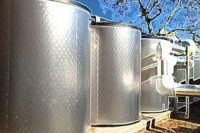Developing a proactive contingency plan is the best way to minimize associated risks and downtime. Some actions that are included in a good plan are identifying cooling requirements and occasions where temporary cooling is needed, selecting a supplier, and site preparation for installation of temporary equipment. Implementing these actions well in advance of the need will keep service disruption to a minimum.
BENEFITS OF A CONTINGENCY PLAN
When a cooling system goes down unexpectedly, the time required to overhaul the system or replace the equipment can have significant financial consequences. Immediate replacement is needed to avoid costly downtime and to keep the building or process operational. A temporary system can restore a building or process to operation quickly, especially if a planned emergency response is in place to lessen the likelihood that a disaster will disrupt business.Facilities can yield multiple benefits from a contingency plan. By being proactive in this matter, facilities can avoid costs by reducing downtime associated with sourcing and determining temporary requirements, minimizing unexpected as well as unavoidable costs. It also provides the fastest return to "normal" mode, allowing staff to implement the contingency plan with one phone call.
Creating a plan beforehand means that when an emergency strikes, the temporary connections (electrical and mechanical) will already be identified and installed. Moreover, all equipment locations, permits, etc., will already be decided and obtained as necessary. Such a plan can also assist the vendor as well as the customer, by providing a ready-made roadmap for solving the problem at the most critical hour.
Planning ahead for temporary cooling needs allows facility owners and managers to control energy costs by pre-selecting the type of equipment that will be applied and the systems by which it will be powered. When considering comfort-cooling applications, established action plans will also reduce the potential for temporary IAQ issues.
PLANNED APPLICATIONS
In addition to an emergency or unplanned downtime, rental equipment is a viable option for planned situations. Here are a few of the most common scenarios.Routine maintenance. Temporary systems provide an excellent way to supply cooling during planned equipment maintenance, eliminating time pressures to get your primary-cooling system back on-line. Operations can continue while maintenance procedures are performed, reducing expense and downtime.
Chiller replacement. Temporary cooling delivers uninterrupted cooling to a building or process during equipment retrofitting, conversion, or new equipment installation. It allows service personnel undisturbed access to the existing cooling system.
Additional cooling capacity. Temporary cooling provides additional capacity when a facility's cooling load exceeds the capability of the current cooling system, whether the increase in the load is the result of seasonal heat waves, special production processes, short-term projects, or special orders.
Standby cooling. Temporary cooling can be used to back up critical systems and provide redundancy should a primary or built-in backup system fail.
System testing or proving. Temporary cooling can be used to determine system requirements or viability before new equipment is purchased. Using a rental system before purchasing a new chiller system could save money and provide a better system design in the long run. In addition, it may be possible for business owners to rent the exact equipment they intend to purchase.
Financial considerations. When a capital budget does not allow for the purchase of a much-needed new chiller, temporary cooling can bridge the gap until budgeting issues can be resolved.
Delayed delivery. Temporary cooling can meet cooling needs when the delivery of a chiller is delayed.
Unique applications. Temporary cooling can satisfy needs that arise during special events, such as conferences, sporting events, political conventions, etc.
SELECTING A SUPPLIER
Contingency planning should include the identification of the specific cooling requirements. Taking this step positions someone to shop for the supplier who can best provide the temporary solution that will meet their needs. When considering suppliers, it is important to ask a few key questions, including the following:EVALUATING THE PROPOSAL
Proposals for temporary solutions should include a description of the application, design conditions, equipment, and the services to be provided by the supplier. In addition, one should obtain details relating to payment schedule, issues of liability coverage, and changeorders. When reviewing the proposal, it is a good idea to be sure that the following questions are answered:SITE PREPARATION
After the cooling requirements have been identified, and the supplier and equipment selected, it is time to prepare the facility for a quick installation of the temporary cooling system. This means installing quick connections to the facility. Both electrical and mechanical connections must be considered and may include bypass valves, breaker panels, duct connections, etc.Some suppliers of temporary cooling solutions will perform facility preparation work as part of an emergency preparedness plan. In the event of an emergency, the information will allow the supplier to respond quickly, providing critical cooling where it is needed, while reducing customer financial risks and downtime.

